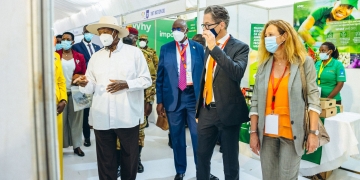Learners at all levels will have to wait a little bit longer after Dr. Diana Atwine, the permanent Secretary in Ministry of Health ruled any possibility of re-opening schools in the near future.
PS. Atwine who toured Kisoro region porous borders said government has not planned for the education sector.
Meeting the leaders of Kisoro district, Atwiine told them that students are among the vulnerable groups which can be greatly affected if they are infected with the virus.
Therefore, it will take time for government to draw a plan to ensure safety of the schools.
President Museveni will tonight at 8:00 pm deliver the much awaited address to the country —guiding on the way forward as the 21-day lockdown extension comes to a close tomorrow, May 05.
Mr. Museveni is expected to announce lifting of some of the current lockdown measures as the country works to stop the spread of coronavirus.
More than 127 million pre-primary, primary, and secondary school students in Eastern and Southern Africa – who are supposed to return to school this week – remain at home, due to the COVID-19 outbreak. In response, UNICEF has announced advanced support to this unprecedented education crisis, while advocating for the safe re-opening of schools that adhere to safety guidance.
In most parts of the world, learning at home has been supported by online tools. However, in Eastern and Southern Africa, internet penetration is constrained – barely one in five (22%) of households have internet access, while 84% of the rural population – where the bulk of the learners reside – have no electricity. Consequently, UNICEF has been working around the clock with partners to support continued learning through means such as radio, SMS and printed materials.
However, even with the alternative learning measures being rolled out by Governments, UNICEF and partners, tens of millions of children will not be reached. Radio, for example, reaches about 53 million children, or four in ten of those across Eastern and Southern Africa. Those not reached are often the most marginalized and vulnerable children who largely rely on schools for their education, health, safety and nutrition. Indeed, the secondary effects of COVID-19 and school closures are grim: across ESA up to 16 million children are no longer accessing critical daily meals at school; and violence is increasing. In March this year there were a staggering 3,000 more calls made to ChildLine, the free counselling helpline in South Africa, than 12 months earlier.
“COVID-19 has triggered an education crisis that is unprecedented in scope, duration and impact,” said UNICEF Regional Director for Eastern & Southern Africa, Mohamed M. Malick Fall. “Governments, business and parents must come together to ensure inclusive, realistic and scalable ways that reach all children. This has started, but every day that passes is another where children – and their communities – are robbed of a fundamental right.”
To this end UNICEF welcomes a new technical guidance “Framework for Reopening Schools” which provides a roadmap for the safe reopening of schools, and was co-authored by the World Food Programme, World Bank, UNESCO and UNICEF.
“We learned many tough lessons from Ebola,” said UNICEF’s Fall, “but one of the most stark was that after prolonged school closures we see increases in child exploitation, in child abuse and even in teenage pregnancies; while it becomes harder for the most vulnerable children to return to school. These are the issues that must be at the forefront of the minds of decision-makers.”











Discussion about this post